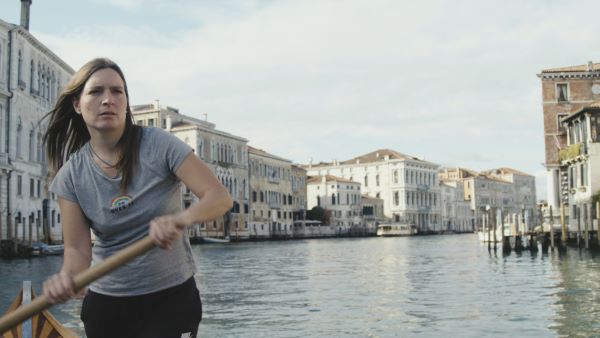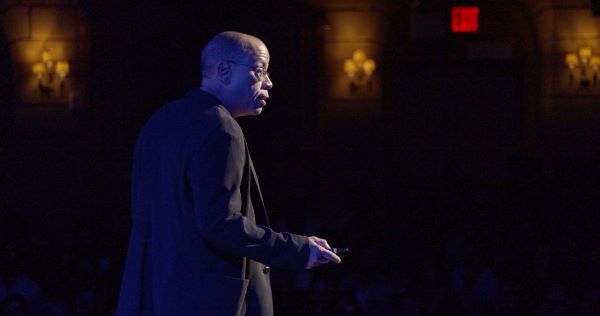
Every year, my Canadian colleagues at the Toronto International Film Festival would highly recommend that city’s springtime Hot Docs Festival. Since 1993, it has become one of the world’s largest documentary overviews on the festival circuit, similar to North Carolina’s Full Frame Documentary Film Fest, the UK’s Sheffield Doc/Fest, and a newer arrival on the scene, DOC NYC. Thanks inadvertently to the pandemic, I have been able for the first time to virtually attend screenings, though only to sample a sliver of the selections.
More than 200 feature films are shown from all over the world and highlighted in categories such as “Hot Picks” (which includes Street Gang: How We Got to Sesame Street), “Artscapes,” and “The Changing Face of Europe.” Although the movies below are only available to Canadian residents online, plenty are bound for statewide and international streaming and, hopefully, theatrical releases in the near future.
The omnipresent epidemic reared its head in at least two films in the rich and varied programming, most noticeably in Wuhan Wuhan, which had its world premiere here. Director Yung Chang’s camera captures the vastness of the city of 11 million, with aerial overviews of the nearly empty roads and the huge skyline of the initial pandemic hot spot.
It begins two months into the lockdown in February 2020 and focuses on a number of story lines, including the easy-going Yin, a factory worker-turned-volunteer medical driver, and his wife, Xu, who is 37 weeks pregnant. Yin dons full protection gear to drive healthcare workers to and from their shifts. At this point during the crisis, one passenger, a radiologist, can’t see the end of the epidemic and also says that the actual numbers of those who have contracted Covid-19 is higher than has been acknowledged officially.
Certain developments will now be familiar to viewers. At Wuhan No. 5 Hospital, there is not enough N95 masks to go around. Flowers are left at the front entrance of Wuhan Central Hospital in memory of Dr. Wenliang Li, the ophthalmologist and whistleblower who notably issued warnings about the impending pandemic in December 2019. Meanwhile, a convention center has been turned into a temporary hospital with more than 2,000 patients who have tested positive and/or have mild COVID-19 symptoms.
Life nevertheless goes on. Besides the challenges of staying healthy, Yin and Xu have a lot of prenatal preparation to do. One of his main tasks is to find an inexpensive crib, a quest that becomes complicated when he cannot enter an apartment building because a resident has a high fever. Coincidentally perhaps, both this film and the recent 76 Days lead up to a climatic sequence in a delivery room. (More than 16,000 babies were born in Wuhan during the lockdown according to Wuhan.)
Though the reactions of those profiled are often candid (one patient is affectionately referred to by a nurse as Grumpy Grampa), the filmmakers accentuate the positive in the city’s response to the virus. (At one intersection, a banner reads “Controlling the Pandemic Is Everybody’s Duty.”) Chang (Up the Yangtze) offers a calm, more narrative-driven change of pace from the aforementioned 76 Days, which is a harrowing look at the pandemic in Wuhan during the same time span: the chaotic panic among patients, the high death rate, and the mental exhaustion among healthcare workers. For a more critical and inquisitive look skewering China’s response to the crisis, as well as that of the Trump administration, director Nanfu Wang’s In the Same Breath is also screening in the festival and will air on HBO later this year.

For armchair travelers climbing the walls to venture out and explore the world, director Andrea Segre offers an eyeful of a deserted and glistening Venice during Italy’s first lockdown in Molecules. Even if one has seen La Serenissima’s emptiness in the news during the last year, his documentary emphasizes the vastness of the sea and how it dominates the city.
The filmmaker and his camera have the city all to themselves. Remarkably, the two major threats to Venice’s future, tourism and high tides, have disappeared. Indeed, the tides are so low that they reveal the watermarks of the centuries-old buildings. One observer, looking out onto the Grand Canal, remarks that this is the first time in 50 years that there is no boat traffic in view. He might be right.
The director began his project on February 22nd, right before the lockdown. February 25th was Carnevale, and at that point, tourists have started to flee. But he keeps filming. To him, Venice is an enigma, the hometown of his dad (whose line of work as a chemist, along with the imposing coronavirus, give the film its title). After his father’s death, Segre discovered footage of the city his dad shot decades ago. He interweaves it along with his ruminations of a parent he really didn’t know, using the city as an entry point to explore their relationship. Yet when Segre’s voice-over touches on his family’s history, the narrative leans toward the abstract and insular. But his personal account has an uphill task gaining traction against the scene stealer that is Venice.

In spite of the global lockdowns, the five-trillion-dollar gig economy has become even more entrenched. But does this line of work really provide workers (an estimated 540 million globally) with independence, flexible hours, and no boss to answer to? Director Shannon Walsh’s answer is, ah, no, in The Gig Is Up.
Although companies initially provide subsidies to, say, Uber drivers, who they consider independent contractors, they later cut employee discounts and pay while building monopolies and dictating terms within a given region. (It’s up to the U.S. workers to have their own health and auto insurance, for example.) Much of what Walsh covers takes place before the worldwide lockdowns. Given that the gig economy has since transformed, this is still a developing story. Nevertheless, the film offers a brisk whirlwind tour of this often invisible work force, including a look at the murky world of Mechanical Turks, those who help clean up databases.
If this subject sounds dry, think again. Walsh serves up a heaping helping of Southern Gothic in her profile of Jason of Florida, who, because of his numerous gold front teeth—and presumably other job disqualifiers—makes money taking internet surveys. He and his mom, Deborah, who repeatedly interrupts his interviews, pull focus. They beg for their own film.

One indisputable highlight at Hot Docs is Who We Are: Chronicle of Racism in America, a visual essay based on a lecture by Jeffery Robinson, deputy legal director of the ACLU, that breaks free from wonky, academic rhetoric. (Don’t worry, you won’t nod off.)
Although he addresses an audience at New York City’s Town Hall, the presentation is intimate, as well as clear, passionate, yet calm, even while he describes some of the most horrific and violent chapters in American history. He suggests or prods viewers, rather than dictate, on how to absorb the content. Given the subject matter, Robinson lowers the temperature in the room while never downplaying the repercussions of slavery throughout U.S. history. He also offers a succinct and an uncontentious definition of white supremacy, one of the numerous reasons why the documentary would ideally complement cultural sensitivity efforts in the workplace and elsewhere.
Directors Emily Kunstler and Sarah Kunstler (William Kunstler: Disturbing the Universe) enrich Robinson’s narrative with numerous insightful interviews. Among the highlights is one of the last known survivors of the 1921 rampage in the Greenwood section of Tulsa, Oklahoma: the still sprightly Lessie Benningfield Randall, who is more than 100 years old; Josephine Bolling McCall, the daughter of Elmore Bowling, a successful businessman who was lynched in the late 1940s in rural Alabama; and Tami Sawyer, a leader of the effort to take down Confederate monuments in Memphis, Tennessee.
This is a more successful examination of the role of white supremacy in U.S. history than Raoul Peck’s recent HBO series Exterminate All the Brutes, which comes across as more scattered and padded in comparison, with its ponderous and redundant reenactments. In under two hours, Robinson delves into many dark historical chapters, illuminating them with depth while linking them together. (It first premiered at this year’s SXSW, where it won an Audience Award.)

One selection that is more than likely to air on PBS stations stateside is director Margaret Byrne’s Any Given Day, which was co-produced by the Corporation for Public Broadcasting. The filmmaker made a film about a subject that she knows well, mental illness. At 14, she was diagnosed with depression. Through her film, she asks, how do you live with mental illness every day?
The documentary estimates that a third of the inmates in Chicago’s correctional system have a mental illness, and it follows three diagnosed parolees through the Cook County Mental Health Court, which emphasizes treatment and rehabilitation. What ensues is a straightforward account of their attempts to live on their own independently.
The result becomes a testament to the trust that nonfiction filmmakers develop with their subjects and gives insight into the documentary production process. There’s barely a dividing line separating this director from her subjects. They are in this project together. Thirtysomething Angela at one point drops out of the project, thinking it will make her look foolish, and an understanding Byrne reassures her that they will remain friends regardless. Additionally, during the filming, Byrne becomes temporarily unable to continue after becoming overprescribed with medication and ending up in a hospital.
Perhaps the one commonality her three subjects share is drug and alcohol abuse; all of them have been using some form of self-medication. With empathy to spare, Any Given Day succinctly reflects the link between addiction and mental health—there are many bumps ahead on the road to recovery.
Other titles at Hot Docs to keep an eye one when they are released in the States later this year include All Light, Everywhere; Faya Dayi; Homeroom; Misha and the Wolves; and The Sparks Brothers.
















Leave A Comment